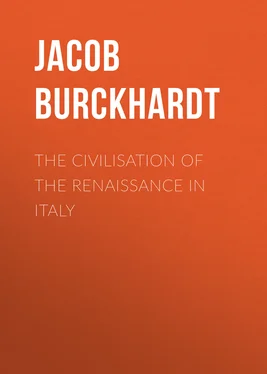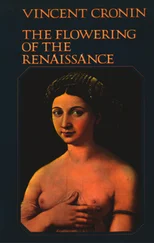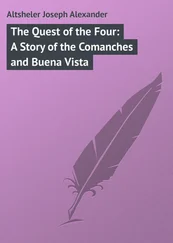Jacob Burckhardt - The Civilisation of the Renaissance in Italy
Здесь есть возможность читать онлайн «Jacob Burckhardt - The Civilisation of the Renaissance in Italy» — ознакомительный отрывок электронной книги совершенно бесплатно, а после прочтения отрывка купить полную версию. В некоторых случаях можно слушать аудио, скачать через торрент в формате fb2 и присутствует краткое содержание. Жанр: foreign_prose, История, foreign_edu, foreign_antique, на английском языке. Описание произведения, (предисловие) а так же отзывы посетителей доступны на портале библиотеки ЛибКат.
- Название:The Civilisation of the Renaissance in Italy
- Автор:
- Жанр:
- Год:неизвестен
- ISBN:нет данных
- Рейтинг книги:5 / 5. Голосов: 1
-
Избранное:Добавить в избранное
- Отзывы:
-
Ваша оценка:
- 100
- 1
- 2
- 3
- 4
- 5
The Civilisation of the Renaissance in Italy: краткое содержание, описание и аннотация
Предлагаем к чтению аннотацию, описание, краткое содержание или предисловие (зависит от того, что написал сам автор книги «The Civilisation of the Renaissance in Italy»). Если вы не нашли необходимую информацию о книге — напишите в комментариях, мы постараемся отыскать её.
The Civilisation of the Renaissance in Italy — читать онлайн ознакомительный отрывок
Ниже представлен текст книги, разбитый по страницам. Система сохранения места последней прочитанной страницы, позволяет с удобством читать онлайн бесплатно книгу «The Civilisation of the Renaissance in Italy», без необходимости каждый раз заново искать на чём Вы остановились. Поставьте закладку, и сможете в любой момент перейти на страницу, на которой закончили чтение.
Интервал:
Закладка:
160
Giov. Villani, xi. 92, 93. In Macchiavelli, Stor. Fiorent. lib. ii. cap. 42, we read that 96,000 persons died of the plague in 1348.
161
The priest put aside a black bean for every boy and a white one for every girl. This was the only means of registration.
162
There was already a permanent fire brigade in Florence.
163
Matteo Villani, iii. 106.
164
Matteo Villani, i. 2-7, comp. 58. The best authority for the plague itself is the famous description by Boccaccio at the beginning of the Decameron .
165
Giov. Villani, x. 164.
166
Ex Annalibus Ceretani , in Fabroni, Magni Cormi Vita , Adnot. 34. vol. ii. p. 63.
167
Ricordi of Lorenzo, in Fabroni. Laur. Med. Magnifici Vita , Adnot. 2 and 25. Paul. Jovius, Elogia , pp. 131 sqq. Cosmus.
168
Given by Benedetto Dei, in the passage quoted above ( p. 70, note 1). It must be remembered that the account was intended to serve as a warning to assailants. For the whole subject see Reumont, Lor. dei Medici , ii. p. 419. The financial project of a certain Ludovico Ghetti, with important facts, is given in Roscoe, Vita di Lor. Med. ii. Append, i.
169
E. g. in the Arch. Stor. iv.(?) See as a contrast the very simple ledger of Ott. Nuland, 1455-1462 (Stuttg. 1843), and for a rather later period the day-book of Lukas Rem, 1494-1541, ed. by B. Greiff, Augsb., 1861.
170
Libri, Histoire des Sciences Mathématiques , ii. 163 sqq.
171
Varchi, Stor. Fiorent. iii. p. 56 and sqq. up to the end of the 9th book. Some obviously erroneous figures are probably no more than clerical or typographical blunders.
172
In respect of prices and of wealth in Italy, I am only able, in default of further means of investigation, to bring together some scattered facts, which I have picked up here and there. Obvious exaggerations must be put aside. The gold coins which are worth referring to are the ducat, the sequin, the ‘fiorino d’oro,’ and the ‘scudo d’oro.’ The value of all is nearly the same, 11 to 12 francs of our money.
In Venice, for example, the Doge Andrea Vendramin (1476) with 170,000 ducats passed for an exceedingly rich man (Malipiero, l. c. vii. ii. p. 666. The confiscated fortune of Colleoni amounted to 216,000 florins, l. c. p. 244.
About 1460 the Patriarch of Aquileia, Ludovico Patavino, with 200,000 ducats, was called ‘perhaps the richest of all Italians.’ (Gasp. Veroneus Vita Pauli II. , in Murat. iii. ii. col. 1027.) Elsewhere fabulous statements.
Antonio Grimani paid 30,000 ducats for his son’s election as Cardinal. His ready money alone was put at 100,000 ducats. ( Chron. Venetum , Murat. xxiv. col. 125.)
For notices as to the grain in commerce and on the market at Venice, see in particular Malipiero, l. c. vii. ii. p. 709 sqq. Date 1498.
In 1522 it is no longer Venice, but Genoa, next to Rome, which ranks as the richest city in Italy (only credible on the authority of Francesco. Vettori. See his history in the Archiv. Stor. Append. tom. vi. p. 343). Bandello, parte ii. novello 34 and 42, names as the richest Genoese merchant of his time Ansaldo Grimaldi.
Between 1400 and 1580 Franc. Sansovino assumes a depreciation of 50 per cent. in the value of money. ( Venezia , fol. 151 bis.)
In Lombardy it is believed that the relation between the price of corn about the middle of the fifteenth and that at the middle of the present century is as 3 to 8. (Sacco di Piacenza, in Archiv. Stor. Append. tom. v. Note of editor Scarabelli.)
At Ferrara there were people at the time of Duke Borso with 50,000 to 60,000 ducats ( Diario Ferrarese , Murat. xxiv. col. 207, 214, 218; an extravagant statement, col. 187). In Florence the data are exceptional and do not justify a conclusion as to averages. Of this kind are the loans to foreign princes, in which the names of one or two houses only appear, but which were in fact the work of great companies. So too the enormous fines levied on defeated parties; we read, e.g. that from 1430 to 1453 seventy-seven families paid 4,875,000 gold florins (Varchi, iii. p. 115 sqq.), and that Giannozzo Mannetti alone, of whom we shall have occasion to speak hereafter, was forced to pay a sum of 135,000 gold florins, and was reduced thereby to beggary (Reumont, i. 157).
The fortune of Giovanni Medici amounted at his death (1428) to 179,221 gold florins, but the latter alone of his two sons Cosimo and Lorenzo left at his death (1440) as much as 235,137 (Fabroni, Laur. Med. Adnot. 2). Cosimo’s son Piero left (1469) 237,982 scudi (Reumont, Lorenzo de’ Medici , i. 286).
It is a proof of the general activity of trade that the forty-four goldsmiths on the Ponte Vecchio paid in the fourteenth century a rent of 800 florins to the Government (Vasari, ii. 114, Vita di Taddeo Gaddi ). The diary of Buonaccorso Pitti (in Delécluze, Florence et ses Vicissitudes , vol. ii.) is full of figures, which, however, only prove in general the high price of commodities and the low value of money.
For Rome, the income of the Curia, which was derived from all Europe, gives us no criterion; nor are statements about papal treasures and the fortunes of cardinals very trustworthy. The well-known banker Agostino Chigi left (1520) a fortune of in all 800,000 ducats ( Lettere Pittoriche , i. Append. 48).
During the high prices of the year 1505 the value of the staro ferrarrese del grano , which commonly weighed from 68 to 70 pounds (German), rose to 1⅓ ducats. The semola or remolo was sold at venti soldi lo staro ; in the following fruitful years the staro fetched six soldi . Bonaventura Pistofilo, p. 494. At Ferrara the rent of a house yearly in 1455 was 25 Lire ; comp. Atti e memorie , Parma, vi. 250; see 265 sqq. for a documentary statement of the prices which were paid to artists and amanuenses.
From the inventory of the Medici (extracts in Muntz, Prècurseurs , 158 sqq.) it appears that the jewels were valued at 12,205 ducats; the rings at 1,792; the pearls (apparently distinguished from other jewels, S.G.C.M.) at 3,512; the medallions, cameos and mosaics at 2,579; the vases at 4,850; the reliquaries and the like at 3,600; the library at 2,700; the silver at 7,000. Giov. Rucellai reckons that in 1473(?) he has paid 60,000 gold florins in taxes, 10,000 for the dowries of his five daughters, 2,000 for the improvement of the church of Santa Maria Novella. In 1474 he lost 20,000 gold florins through the intrigues of an enemy. ( Autografo dallo Tibaldone di G.R. , Florence, 1872). The marriage of Barnardo Rucellai with Nannina, the sister of Lorenzo de’ Medici, cost 3,686 florins (Muntz, Précurseurs , 244, i).
173
So far as Cosimo (1433-1465) and his grandson Lorenzo Magnifico (d. 1492) are concerned, the author refrains from any criticism on their internal policy. The exaltation of both, particularly of Lorenzo, by William Roscoe ( Life of Lorenzo de’ Medici, called the Magnificent , 1st ed. Liverpool, 1795; 10th ed. London, 1851), seems to have been a principal cause of the reaction of feeling against them. This reaction appeared first in Sismondi ( Hist. des Rép. Italiennes , xi.), in reply to whose strictures, sometimes unreasonably severe, Roscoe again came forward ( Illustrations, Historical and Critical, of the Life of Lor. d. Med. , London, 1822); later in Gino Capponi ( Archiv. Stor. Ital. i. (1842), pp. 315 sqq.), who afterwards ( Storia della Rep. di Firenze , 2 vols. Florence, 1875) gave further proofs and explanations of his judgment. See also the work of Von Reumont ( Lor. d. Med. il Magn. ), 2 vols. Leipzig, 1874, distinguished no less by the judicial calmness of its views than by the mastery it displays of the extensive materials used. See also A. Castelman: Les Medicis , 2 vols. Paris, 1879. The subject here is only casually touched upon. Comp. two works of B. Buser (Leipzig, 1879) devoted to the home and foreign policy of the Medici. (1) Die Beziehungen der Medicus zu Frankreich. 1434-1494, &c. (2) Lorenzo de’ Medici als italienischen Staatsman , &c., 2nd ed., 1883.
Читать дальшеИнтервал:
Закладка:
Похожие книги на «The Civilisation of the Renaissance in Italy»
Представляем Вашему вниманию похожие книги на «The Civilisation of the Renaissance in Italy» списком для выбора. Мы отобрали схожую по названию и смыслу литературу в надежде предоставить читателям больше вариантов отыскать новые, интересные, ещё непрочитанные произведения.
Обсуждение, отзывы о книге «The Civilisation of the Renaissance in Italy» и просто собственные мнения читателей. Оставьте ваши комментарии, напишите, что Вы думаете о произведении, его смысле или главных героях. Укажите что конкретно понравилось, а что нет, и почему Вы так считаете.












